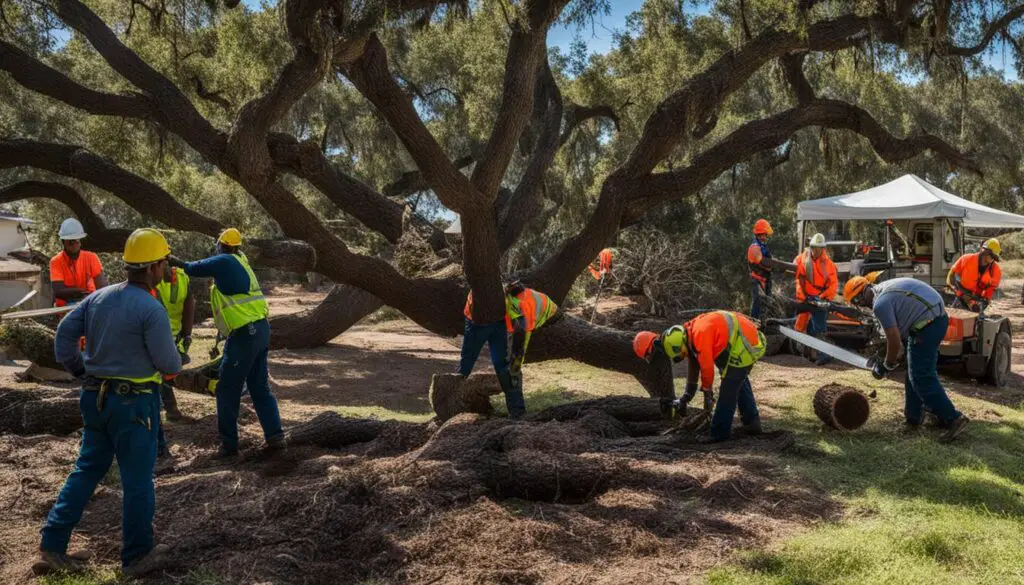Live oak trees, scientifically known as Quercus virginiana, are renowned for their majestic presence in Southern landscapes. These trees thrive in warm, humid environments, typically found in USDA Zones 8-10. However, their growth rate can vary depending on various factors.
Key Takeaways:
- Live oak trees, also known as Quercus virginiana, are iconic trees in the Southern regions.
- They thrive in warm, humid environments, typically in USDA Zones 8-10.
- The growth rate of live oak trees can vary depending on factors such as soil conditions and climate.
- Optimal conditions for live oak tree growth include well-drained, sandy soils and plenty of moisture.
- Young live oak trees generally have a moderate growth rate of around 2 to 2½ feet per year.
Factors Influencing Live Oak Tree Growth
The growth rate of live oak trees is determined by various factors that influence their development. To achieve optimal growth, live oak trees require specific conditions, including well-drained, sandy soils and ample moisture. Although live oak trees typically exhibit moderate growth during their youthful years, with a growth rate of approximately 2 to 2½ feet per year, the rate may vary depending on the region of cultivation. Trees grown outside coastal areas may experience slower growth rates.
As live oak trees age, their growth rate gradually decreases. However, it is important to note that some live oak trees can live for several hundred years despite the slower growth rate. This long life span contributes to their iconic presence in Southern landscapes.
| Factors Affecting Live Oak Tree Growth | Optimal Conditions for Live Oak Tree Growth | Live Oak Tree Growth Timeline |
|---|---|---|
| Well-drained, sandy soils | Ample moisture | Moderate growth rate in youth, slows with age |
| Region of cultivation | Several hundred years life span |
These factors directly impact the growth and health of live oak trees, highlighting the importance of providing the optimal conditions for their cultivation and maintenance. Understanding the growth timeline of live oak trees can aid in effective care and ensure their long-term survival.
Mature Size of Live Oak Trees
Live oak trees are known for their majestic presence and massive size. These trees have wide-spreading evergreen crowns that create a picturesque landscape. The mature size of live oak trees can vary depending on the environment and growth conditions.
In open landscapes, live oak trees can reach impressive heights of 40 to 80 feet, with widths ranging from 60 to 100 feet. Their sprawling branches and lush foliage make them a remarkable sight. However, in forested areas where competition for sunlight is greater, live oak trees tend to grow more erect and can reach heights of up to 100 feet.
Understanding the growth stages and habits of live oak trees is essential for proper care and management. These trees go through different growth stages, starting as saplings and progressing into mature trees over time. Each stage has its own unique growth characteristics and requirements, ensuring the tree’s continued health and vitality.

“Live oak trees are massive and picturesque, with wide-spreading evergreen crowns.”
Ornamental Features of Live Oak Trees
Live oak trees are known for their unique and ornamental features. These majestic trees exhibit distinct characteristics that make them a prized addition to any landscape.
Large, Horizontal Limbs: Live oak trees have large, horizontal limbs that give them a grand and imposing appearance. These wide-spreading branches create a picturesque silhouette against the sky, making live oak trees instantly recognizable.
Impressive Trunk Size: The trunks of live oak trees can grow to more than six feet in diameter, showcasing their strength and resilience. These thick and sturdy trunks contribute to the overall grandeur of these trees.
Evergreen Leaves: Live oak trees have waxy, leathery leaves that remain on the tree throughout winter. This evergreen foliage adds a touch of greenery and life to the landscape even during the colder months.
Acorn Production: Live oak trees produce acorns, which are a primary source of food for various wildlife species. These acorns serve as an important food source along the coastal areas, supporting the local ecosystem.
To get an idea of the growth stages and habits of live oak trees, refer to the growth chart below:
| Growth Stage | Description |
|---|---|
| Sapling | The tree is young and relatively small, with a developing root system. |
| Young Tree | The tree has established a solid trunk and is growing rapidly. |
| Mature Tree | The tree has reached its full size and is producing acorns. |
| Old Tree | The tree has aged and may show signs of decline, but can still live for many more years. |
These growth stages give an overview of how live oak trees develop and grow over time. By understanding these growth habits and stages, you can better appreciate the journey of these remarkable trees.
Problems and Diseases Affecting Live Oak Trees
While live oak trees are known for their resilience, they can still encounter certain problems and diseases that affect their health. Understanding these issues is crucial for maintaining the vitality of live oak trees and ensuring their long-term survival.
Common Issues:
- Leaf Blister: This fungal infection causes raised blisters on the leaves of live oak trees. While it can be unsightly, it typically does not cause significant harm to the tree’s overall health.
- Insect Galls: Live oak trees often develop galls, which are abnormal growths caused by insects. These galls are usually harmless and do not pose a serious threat to the tree’s well-being.
“Live oak trees are strong and can withstand many challenges, but they are not immune to certain issues. Protection and proactive care are essential for maintaining their health and beauty.”
Major Diseases:
Live oak trees are generally resistant to oak wilt disease, a serious fungal infection that affects certain oak species. However, there have been no documented cases of oak wilt on live oak trees.
In colder regions, live oak trees may be susceptible to cold damage. Freezing temperatures can cause injury to branches and tree tissue, compromising their overall health and vitality.
| Disease | Description |
|---|---|
| Leaf Blister | A fungal infection that causes raised blisters on the leaves. Typically harmless and only affects the appearance of the tree. |
| Insect Galls | Abnormal growths on the tree caused by insects. These galls are generally harmless and do not pose a significant threat. |
| Oak Wilt | A serious fungal disease affecting certain oak species. Live oak trees are resistant to oak wilt disease. |
| Cold Damage | Freezing temperatures can cause injury to branches and tree tissue, compromising the health of live oak trees in colder regions. |
Proper care and maintenance, including regular inspections, prompt treatment of issues, and providing optimal growing conditions, can help maintain the health and vigor of live oak trees.

Landscape Use and Cultivars of Live Oak Trees
Live oak trees are highly valued for their aesthetic appeal in landscaping, particularly for creating a Southern charm. These majestic trees are commonly planted along avenues, driveways, and as lawn specimens, adding a touch of elegance to outdoor spaces.
When incorporating live oak trees into your landscape, it’s important to consider their preferred growing conditions. Live oak trees thrive in well-drained, sandy soils that retain moisture. However, they can also tolerate drier and more compacted soils, making them adaptable to various environments.
Did You Know? Live oak trees (Quercus virginiana) are one of the few oak species that can withstand salty soils, making them an excellent choice for coastal landscapes.
Another aspect to consider when choosing live oak trees for your landscaping project is the availability of different cultivars. Cultivars are cultivated varieties of plants that possess specific traits or characteristics. Several cultivars of live oak trees have been developed, each with its own unique growth habits and sizes.
| Cultivar | Description |
|---|---|
| Highrise® | A tall and narrow cultivar that is perfect for urban landscapes with limited space. It features a compact crown and can reach heights of up to 50 feet. |
| Cathedral Oak™ | An impressive cultivar with a wide-spreading crown that resembles the grandeur of cathedral architecture. It creates a stunning focal point in larger landscapes and can reach heights of up to 80 feet. |
| Regal Prince® | A compact cultivar that is ideal for smaller yards or urban settings. It has a more upright growth habit and reaches heights of about 35 feet. |
By selecting the appropriate cultivar of live oak tree, you can tailor its appearance to suit your specific landscaping needs. Whether you desire a slender, vertical accent or a majestic, wide-spreading crown, there is a cultivar available to fulfill your vision.
When landscaping with live oak trees, their size and growth habits should be taken into account, considering both their current and potential dimensions. This thoughtful planning ensures that the trees will harmonize with other elements in your landscape and will not require excessive pruning or maintenance in the future.
Pruning and Maintenance of Live Oak Trees
Proper live oak tree pruning is crucial for the development of a strong branch structure and overall tree health. Pruning helps to remove dead or weak branches, improves sunlight penetration to the inner canopy, and enhances the tree’s natural shape and aesthetics. In the case of young live oak trees, pruning is especially important to train them to grow a central leader and eliminate multiple trunks and competing branches.
It is recommended to prune live oak trees during mid-to-late summer to avoid the spread of oak wilt disease, which is more prevalent during active sap flow in spring and early summer. Restricting pruning during these seasons helps prevent the transmission of the oak wilt fungus through the open wounds.
Once live oak trees are established, they exhibit excellent drought tolerance and require minimal maintenance. Regular inspections for signs of disease, pests, or structural issues are advisable, but avoid excessive pruning that may compromise the tree’s natural defenses.
Benefits of Pruning Live Oak Trees
Pruning live oak trees offers several benefits:
- Enhances structural integrity and stability by removing weak or hazardous branches;
- Improves overall tree health by increasing air circulation and sunlight penetration;
- Preserves and enhances the tree’s natural form and aesthetics;
- Reduces the risk of damage to property and persons from falling branches;
- Minimizes the risk of infection by reducing wounds and potential disease transmission.
Proper Techniques for Pruning Live Oak Trees
When pruning live oak trees, it’s important to follow proper techniques to minimize the risk of damage or disease:
- Consult an Arborist: For extensive pruning or trees near powerlines, it’s advisable to hire a certified arborist to ensure safety and tree health.
- Identify Dead or Diseased Branches: Remove dead, diseased, or damaged branches promptly to prevent the spread of decay or disease.
- Prune Back to the Collar: Make clean cuts just outside the branch collar, the swollen area where the branch attaches to the trunk or larger limbs.
- Avoid Topping: Do not remove the top of the tree or large branches, as this practice can severely damage the tree and promote weak, multiple branch growth.
- Proper Pruning Equipment: Always use sharp, clean pruning tools and sanitize them between cuts if working with diseased trees.
- Consider Professional Help: For larger pruning jobs or if unsure about proper pruning techniques, it’s best to consult a certified arborist to ensure the tree’s long-term health and aesthetics.
Image

Summary
Pruning is an essential part of live oak tree maintenance. Proper pruning techniques help promote a strong branch structure, enhance tree health, and preserve the tree’s natural form and aesthetics. It’s important to prune live oak trees during the appropriate season to avoid the spread of oak wilt disease. Once established, these majestic trees require minimal maintenance and exhibit excellent drought tolerance.
Growth and Conservation of Live Oak Trees
Live oak trees have a relatively fast growth rate in their youth but slow down as they age. These majestic trees can live for several centuries, with some known to be over a thousand years old. Their longevity is a testament to their resilience and adaptability to various environments.
Although live oak trees were historically used for timber, they are not commonly harvested anymore due to the prevalence of pests, diseases, and the vulnerability to freezing temperatures. Conservation efforts are crucial to protect these iconic trees and ensure their survival for future generations.
Threats to Live Oak Trees:
- Urbanization and habitat loss: As human populations expand, natural habitats are being replaced with urban developments, reducing the available space for live oak trees to thrive.
- Disease outbreaks: Live oak trees are susceptible to various diseases, including oak wilt and root rot, which can severely impact their health and vitality.
- Invasive species: Certain invasive insects and plants pose threats to live oak trees by causing damage to their foliage, roots, or competing for resources.
- Climate change: Rising temperatures and unpredictable weather patterns can affect the growth and survival of live oak trees, especially in areas where they are not adapted to extreme cold or drought conditions.

Efforts to conserve live oak trees and their natural habitats are vital for preserving the unique beauty and ecological importance of these trees. Conservation initiatives include:
Preserving natural habitats: Protecting areas where live oak trees grow naturally, such as forests, coastal regions, and parks, helps maintain the ecosystem balance and provides a safe haven for these trees.
Educational programs: Raising awareness about the value of live oak trees and promoting sustainable practices can help protect and preserve these trees for future generations.
Tree planting initiatives: Planting live oak trees in suitable environments and urban areas can contribute to their conservation and enhance the natural beauty of our landscapes.
Pest and disease management: Implementing effective pest and disease management strategies can help mitigate the impact of damaging organisms on live oak trees.
By taking proactive steps to address the threats facing live oak trees and promoting their conservation, we can ensure that these magnificent trees continue to thrive and enrich our ecosystems for years to come.
Range and Life History of Live Oak Trees
Live oak trees, scientifically known as Quercus virginiana, are native to the southeastern United States, ranging from Virginia to Florida and west to Texas and Oklahoma. These trees have adapted to thrive in a variety of environments, making them a common sight in the region.
Live oak trees are well-suited to coastal areas, where they grow in salty soils and tolerate shade. Their ability to withstand harsh conditions and outcompete less tolerant trees has made them a dominant species in coastal ecosystems.
The life history of live oak trees is fascinating. They are fast-growing in their early years, with an average growth rate of around 2 to 2½ feet per year. However, as they mature, their growth rate slows down significantly. Despite this, live oak trees can live for several hundred years, making them long-lived species.
In the spring, live oak trees produce small, brown flowers that may go unnoticed by many. These flowers serve as important food sources for various animals, including birds, bees, and butterflies. The presence of live oak trees in an area can support diverse wildlife populations.
Fun Facts about Live Oak Trees
Live oak trees have many interesting facts associated with them. They are known for their incredibly strong wood, which was historically used for ship-building. The largest southern live oaks have crown spreads of nearly 150 feet, and some of the oldest live oak trees in the country are estimated to be several hundred years old. These trees play important ecological roles, providing habitat and food sources for various wildlife species.
| Live Oak Tree Facts |
|---|
| Strong wood used for ship-building |
| Largest southern live oaks have crown spreads of nearly 150 feet |
| Some of the oldest live oak trees in the country are estimated to be several hundred years old |
| Provide habitat and food sources for various wildlife species |
Importance of Pruning for Live Oak Trees
Proper pruning is essential for the health and structural integrity of live oak trees. Pruning helps develop a strong branch structure and reduces the risk of disease, limb failure, and potential hazards. By removing dead, damaged, or diseased branches, you can enhance the aesthetic appeal of the tree and promote its overall well-being.
Pruning live oak trees provides several important benefits:
- Improved safety: Regular pruning removes weak or overgrown branches that could pose a safety risk, especially during storms or high winds.
- Enhanced tree structure: Pruning helps develop a balanced and sturdy branch framework, ensuring that the tree can withstand external pressures better.
- Promotion of tree health: Thinning the crown and improving air circulation allows sunlight to reach the inner branches, reducing the risk of fungal infections and promoting overall tree health.
- Controlled growth: Pruning can help manage the size and growth rate of live oak trees, ensuring they don’t outgrow their designated space and interfere with nearby structures or power lines.
- Aesthetic appeal: Properly pruned live oak trees have an attractive appearance, adding value and beauty to any landscape or property.
In order to achieve the maximum benefits of pruning, it is important to adhere to the recommended pruning practices:
- Prune young trees: Start pruning live oak trees in their early years, focusing on removing any competing branches or multiple trunks to encourage a central leader and strong structure.
- Prune periodically: As live oak trees mature, they will still require periodic pruning to maintain their health and structural integrity. This may involve removing dead wood, thinning the crown, or shaping the tree’s overall form.
- Time your pruning: Preferably, prune live oak trees during the mid-to-late summer when oak wilt disease is less likely to spread.
Conclusion
Live oak trees, with their moderate growth rate, are truly remarkable. These trees have the potential to live for several hundred years, adding a touch of elegance and grandeur to any landscape. To ensure the healthy development of live oak trees, it is essential to provide them with optimal conditions, including well-drained soil and an ample water supply.
Pruning and regular maintenance play a crucial role in the care of live oak trees. By properly pruning and eliminating weak or diseased branches, we can promote a strong and structured growth pattern. This reduces the risk of disease and limb failure, ensuring the longevity of these majestic trees.
Conservation efforts are of utmost importance in protecting live oak trees and preserving their natural habitats. As iconic symbols of the Southern landscape, live oak trees provide valuable ecological benefits, serving as habitats and food sources for various wildlife species. By promoting conservation initiatives, we can ensure that future generations can continue to enjoy the beauty and benefits of these magnificent trees.
FAQ
How fast do live oak trees grow?
Live oak trees have a moderate growth rate, typically growing around 2 to 2½ feet per year in their youth. However, the growth rate may vary depending on factors such as location and soil conditions.
What are the factors influencing live oak tree growth?
The growth of live oak trees is influenced by factors such as soil type, moisture, and drainage. Optimal conditions for their growth include well-drained, sandy soils and plenty of moisture.
What is the mature size of live oak trees?
Live oak trees can reach heights of 40 to 80 feet and widths of 60 to 100 feet in open landscapes. In forested areas, they can grow up to 100 feet in height.
What are the ornamental features of live oak trees?
Live oak trees have wide-spreading evergreen crowns and large horizontal limbs that create a majestic appearance. The trunks of live oak trees can grow to more than six feet in diameter, and their leaves remain on the tree throughout winter.
What problems and diseases can affect live oak trees?
Live oak trees may experience leaf blister and insect galls, which are common issues but generally do not cause significant harm. However, oak wilt, a serious fungal disease that can affect some oak species, has not been documented on live oak trees.
How are live oak trees used in landscaping?
Live oak trees are often used in landscaping to create a Southern aesthetic. They are commonly planted along avenues, drives, and as lawn specimens. Live oak trees prefer well-drained, sandy soils with plenty of moisture, but they can tolerate drier and more compacted soils.
How should live oak trees be pruned and maintained?
Proper pruning is essential for the development of a strong branch structure in live oak trees. Young trees should be trained to grow a central leader by eliminating multiple trunks and branches. Pruning should be done in mid-to-late summer to avoid oak wilt disease.
How are live oak trees grown and conserved?
Live oak trees have a relatively fast growth rate in their youth but slow down as they age. Conservation efforts aim to protect live oak trees and their natural habitats due to their historical and ecological significance.
What is the range and life history of live oak trees?
Live oak trees are native to the southeastern United States, ranging from Virginia to Florida and west to Texas and Oklahoma. They grow well in salty soils and shade, and some live oak trees are estimated to be several hundred years old.
What are some fun facts about live oak trees?
Live oak trees are known for their incredibly strong wood and the large crown spreads of the largest southern live oaks, which can reach nearly 150 feet. Some of the oldest live oak trees in the country are estimated to be several hundred years old.
Why is pruning important for live oak trees?
Pruning is crucial for the development of a strong branch structure in live oak trees and reduces the risk of disease and limb failure. Regular pruning in the early years and periodic pruning as the trees mature are recommended.
What are the key takeaways for live oak tree growth and care?
Live oak trees have a moderate growth rate and require optimal conditions, such as well-drained soil and plenty of moisture, to thrive. Pruning, maintenance, and proper care are essential for the health and longevity of live oak trees. Conservation efforts are important in protecting these iconic trees and their natural habitats.

